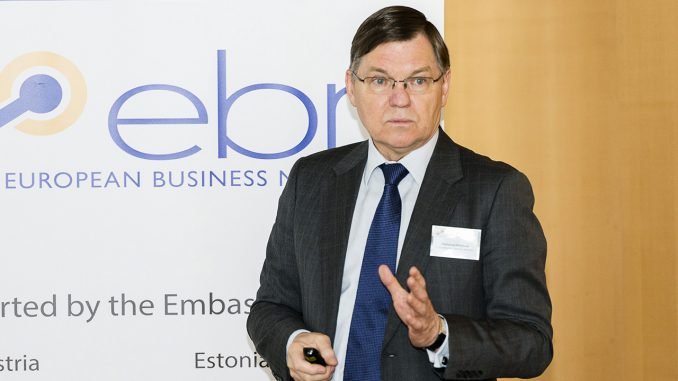
Although the Vice-Minister often made comparisons with the Baltic states, it was the comparisons with EU averages that are most meaningful, as closing that gap will address some demographic issues and improve the overall wellbeing of Lithuania’s society.
Rimkūnas expects economic growth to rise faster than it has, bridging the gap between the national Lithuanian and EU average and putting the country in a stronger fiscal position. The forecasted GDP growth of 2.5% for 2016, after a weak 2015, is expected to rise to 3% by the end of the decade.
That 3% is absolutely needed for Lithuania to catch up to the EU average, where it still has a gap of 25%. Nevertheless, only Ireland, Malta, Luxembourg and Slovakia are expected to do better than Lithuania. Although inflation was negative in 2015, the Vice-Minister sees it rising slowly this year to the ECB target of 2%.
During the presentation, Rimkūnas saw a lot of strengths for the country in the years ahead, but serious challenges that the incoming government will need to tackle after the autumn elections. One of the more acute problems is the decline of the working-age population (-1,3%), which is projected to persist well into 2019 and beyond. Investments from European structural funds, at 27% of the national budget, still make up a very large chunk of Lithuanian revenue, and that share will start declining after 2020.
The good news is that salaries are increasing by 5 to 7%, though they are still very competitive on an EU level. The average gross wages are lower than in Latvia and at €712 a month, 30% lower than in Estonia. Over the last 5 years, salaries have been growing consistently, though at a slower pace than in Latvia and Estonia. Rimkūnas believes unemployment will continue to decline over the next few years, reaching 5% by 2019, which would be lower than the EU average and substantially lower than that of neighbouring Baltic States.
Lower unemployment and salary growth is good, but productivity should also stay ahead. Investment growth in the EU has still not recovered from pre-2008 crisis levels.
The ageing population and the demographic “brain-drain” trend of employable people leaving the country adds to the mismatch between labour needs and educational output. The latter was pointed out by the OECD – the club of rich countries that Lithuania is still trying to become a member of. The Vice-Minister particularly lamented the over-production of certain university graduates, for which there is little chance to find employment, all whilst employers lobby the government to provide work permits to let foreign workers in to fill the gaps of skilled workers needed that are not produced by the country’s educational system.
Exports declined in 2015 as the boycott of Lithuanian and EU goods by Russia, combined with the Russian recession and the steep fall of the Ruble, all forced Lithuanian producers to diversify their export markets. That is a good thing, but it can be painful in the short term, as Germany, the US and several Asian countries are considered more stable in the long term. Rimkūnas said he considered the export growth to become the driving force for the Lithuanian economy in the coming years.
In 2015, domestic consumption made up for that export shortfall, helped by lower fuel and energy costs as global oil prices declined. The country also diversified its energy suppliers and gained substantial energy independence. Although imports exceed exports, it is mainly capital goods that are expected to benefit the Lithuanian economy in the long term. Quantitative easing keeps borrowing costs low. Moreover, businesses took advantage of lower currency exchange costs as the country started to see the full benefit of joining the Euro area.
Although many may complain about taxes, on an EU level, the government’s tax income as part of GDP is below average and, together with Latvia, among the lowest in the EU. Rimkūnas pointed out that few governments dare to raise taxes during an election year and that the focus of the Ministry of Finance has turned to tax compliance and improved collection. Lithuania has managed to keep its debt load relatively low at just below 40%, a hopeful sign thanks in no small part to the extremely prudent legacy of the Kubilius government.
During these difficult years Lithuania scraped by without the need for a bailout, although borrowing costs during that time were sky high. Lithuania scored in the top 5 for keeping a lid on the deficit in 2015, with just a fraction below balancing its budget. There may be a slight deficit again in 2016 again with the goal of balancing the budget in 2017.

Be the first to comment